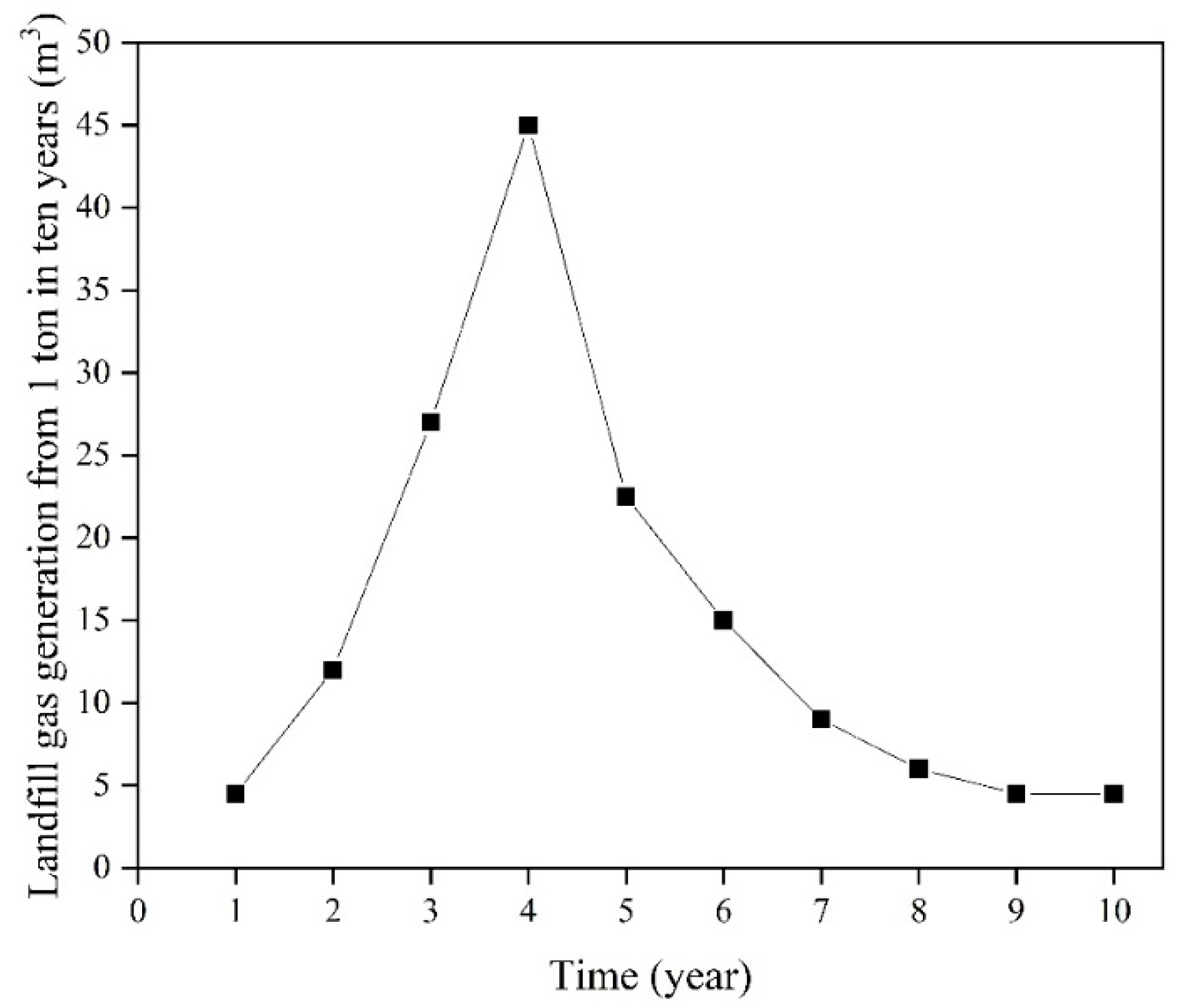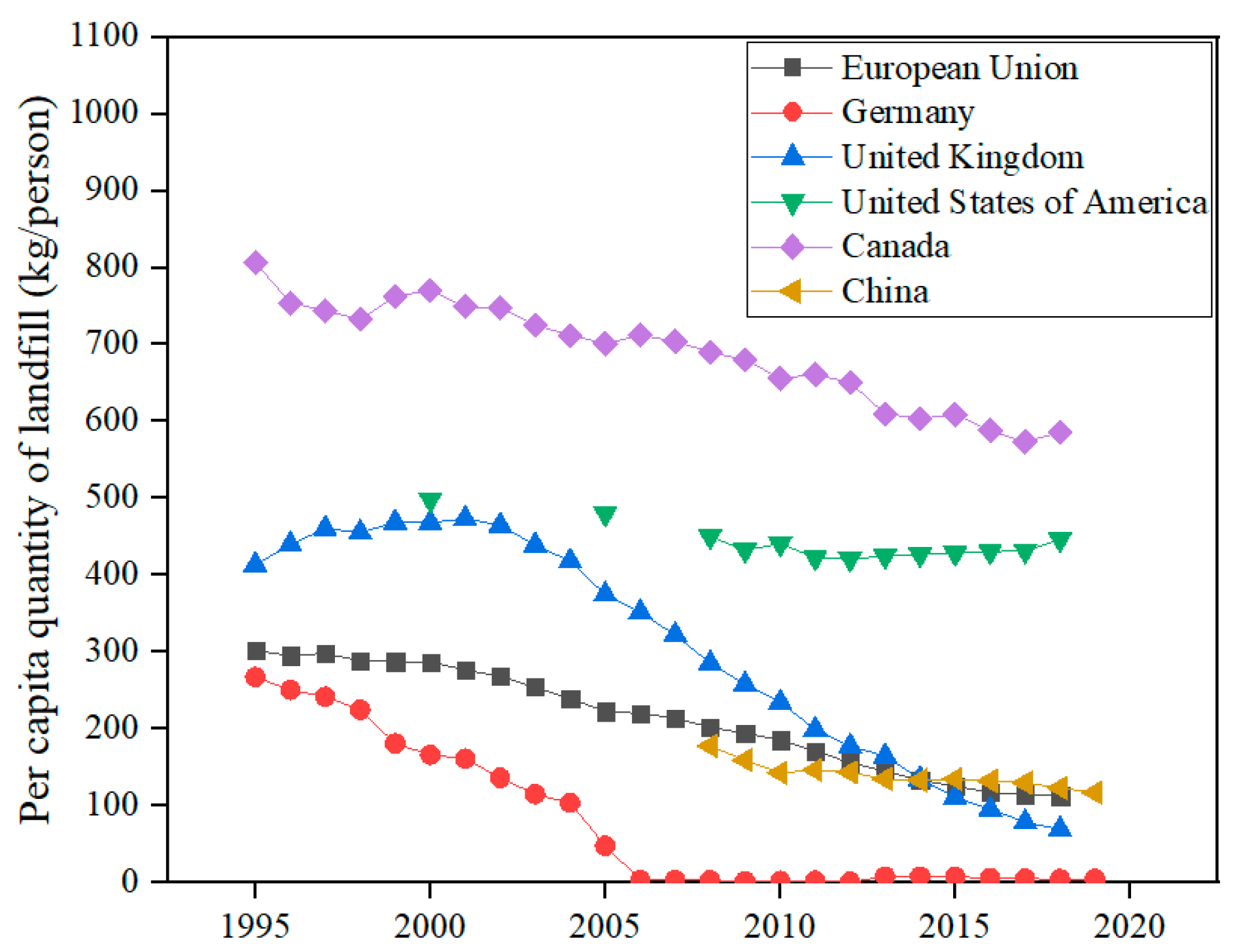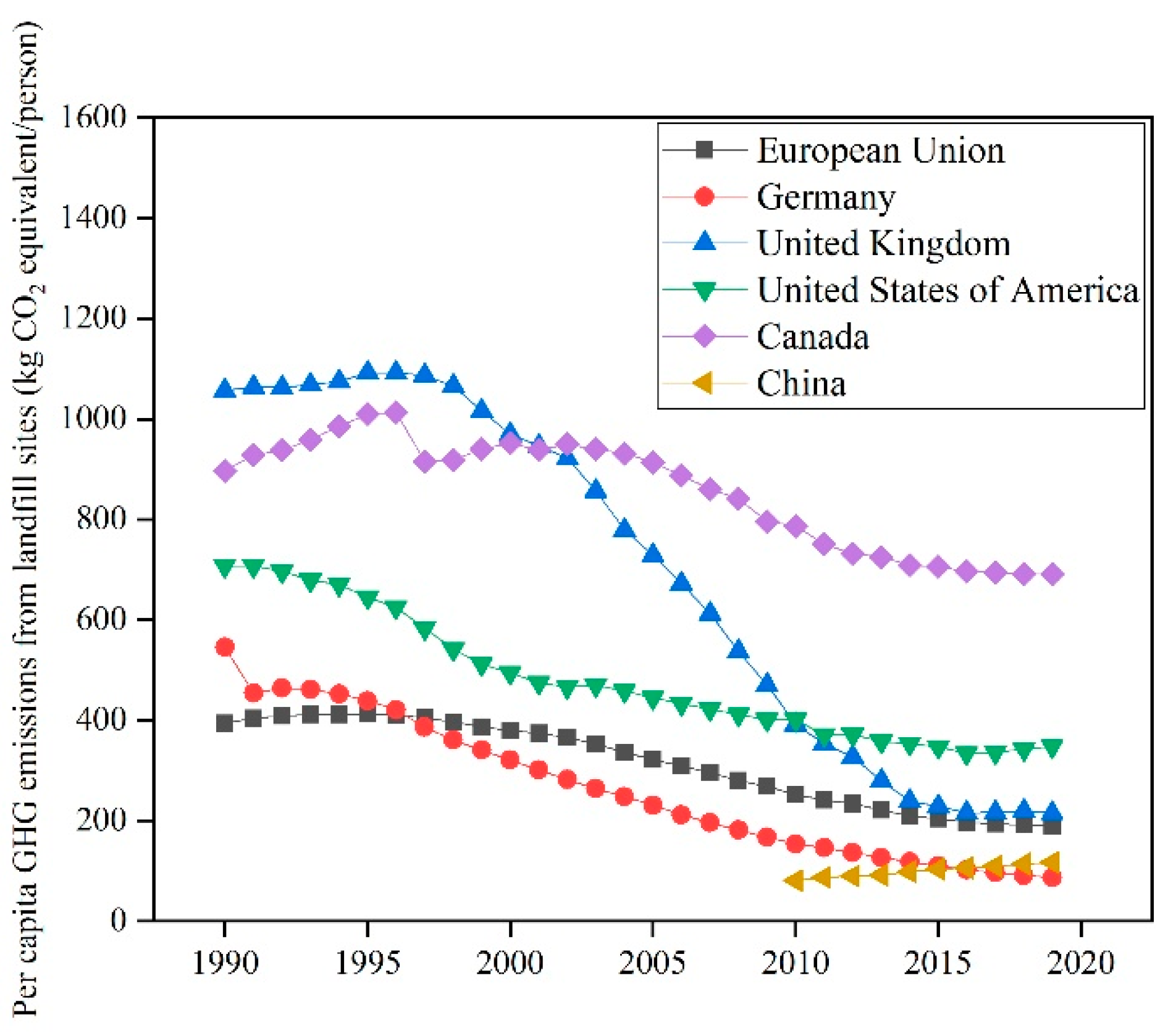Greenhouse Gas Emissions in the Process of Landfill Disposal in China
Abstract
:1. Introduction
2. Materials and Methods
2.1. Data Sources
2.2. Physical Component of Solid Waste
2.3. Landfill Gas Production
2.4. Emission Factors for GHG Inventory Calculation
3. Results
3.1. Amount of Solid Waste Landfill in China
3.2. GHG Emissions from Landfill Sites in China
3.3. Per Capita Quantity of Landfill
3.4. Per Capita GHG Emissions from Landfill Sites
3.5. Implied Emission Factor of CH4 from Landfill
4. Conclusions
- (1)
- Strengthen the source reduction measures to reduce the amount of solid waste generation;
- (2)
- Increase the recycling and utilization of landfill gas;
- (3)
- Avoid the entry of the organic fraction of waste into landfill;
- (4)
- Screen the excavation of old landfills to avoid the continued release of methane gas;
- (5)
- Increase the proportion of incineration in the solid waste treatment system.
Author Contributions
Funding
Institutional Review Board Statement
Data Availability Statement
Conflicts of Interest
References
- Ge, W.; Deng, L.; Wang, F.; Han, J. Quantifying the contributions of human activities and climate change to vegetation net primary productivity dynamics in China from 2001 to 2016. Sci. Total Environ. 2021, 773, 145648. [Google Scholar] [CrossRef] [PubMed]
- Michel, C.P.; Gerson, A.M.; Sandro, D.M.; Ana, P.B.; Jose, P.O.; Luiz, A.K. Municipal solid waste management: Integrated analysis of environmental and economic indicators based on life cycle assessment. J. Clean. Prod. 2020, 254, 119848. [Google Scholar] [CrossRef]
- Ren, L.; Zhou, S.; Peng, T.; Ou, X. Greenhouse gas life cycle analysis of china’s fuel cell medium- and heavy-duty trucks under segmented usage scenarios and vehicle types. Energy 2022, 249, 123628. [Google Scholar] [CrossRef]
- Masson-Delmotte, V.; Zhai, P.; Pirani, A.; Connors, S.L.; Péan, C.; Chen, Y.; Goldfarb, L.; Gomis, M.I.; Matthews, J.B.R.; Berger, S.; et al. IPCC, 2021: Summary for Policymakers. In Climate Change 2021: The Physical Science Basis. Contribution of Working Group I to the Sixth Assessment Report of the Intergovernmental Panel on Climate Change; Cambridge University Press: Cambridge, UK, 2021. [Google Scholar]
- IPCC, 2006. 2006 IPCC Guidelines for National Greenhouse Gas Inventories. In The National Greenhouse Gas Inventories Programme; IGES: Kanagawa, Japan, 2006. [Google Scholar]
- Pilzecker, A.; Fernandez, R.; Mandl, N.; Rigler, E. Annual European Union Greenhouse Gas Inventory 1990–2019 and Inventory Report 2021: Submission to the UNFCCC Secretariat; European Union: Minato, Tokyo, 2021. [Google Scholar]
- Magazzino, C.; Mele, M.; Schneider, N.; Sarkodie, S.A. Waste generation, wealth and GHG emissions from the waste sector: Is Denmark on the path towards circular economy? Sci. Total Environ. 2021, 755, 142510. [Google Scholar] [CrossRef] [PubMed]
- Ministry of Housing and Urban and Rural Development of the People’s Republic of China. Statistical Yearbook of Urban and Rural Construction. Available online: https://www.mohurd.gov.cn/gongkai/fdzdgknr/sjfb/tjxx/index.html (accessed on 1 May 2020).
- National Development and Reform Commission. The People’s Republic of China Initial National Communication on Climate Change; National Development and Reform Commission: Beijing, China, 2004. (In Chinese)
- National Development and Reform Commission. The People’s Republic of China Second National Communication on Climate Change; National Development and Reform Commission: Beijing, China, 2013. (In Chinese)
- National Development and Reform Commissiona. The People’s Republic of China Third National Communication on Climate Change; National Development and Reform Commission: Beijing, China, 2018. (In Chinese)
- National Development and Reform Commission. The People’s Republic of China First Biennial Update Report on Climate Change; National Development and Reform Commission: Beijing, China, 2016. (In Chinese)
- National Development and Reform Commission. The People’s Republic of China Second Biennial Update Report on Climate Change; National Development and Reform Commission: Beijing, China, 2018. (In Chinese)
- The People’s Republic of China; Zhiyuan, O.; Zuoting, S.; Minjun, S.; Dewei, Y.; Ruyin, L. Challenges and Countermeasures of “Carbon Peak and Carbon Neutrality”. J. Hebei Univ. Econ. Bus. 2021, 42. (In Chinese) [Google Scholar] [CrossRef]
- The Ministry of Housing and Urban-Rural Development is a ministry of the People’s Republic of China. Statistical Yearbook of Urban and Rural Construction (2010–2019). 2020. Available online: http://www.mohurd.gov.cn/xytj/tjzljsxytjgb/jstjnj/index.html (accessed on 1 May 2020).
- Pinjing, H.; Miao, C.; Na, Y.; Liming, S. GHG emissions from Chinese MSW incineration and their influencing factors-Case study of one MSW incineration plant in Shanghai. China Environ. Sci. 2011, 31, 402–407. [Google Scholar]
- Christensen, T.H.; Gentil, E.; Boldrin, A.; Larsen, A.W.; Weidema, B.; Hauschild, M.Z. C balance, carbon dioxide emissions and global warming potentials in LCA-modelling of waste management systems. Waste Manag. Res. 2009, 27, 707–715. [Google Scholar] [CrossRef]
- Córdoba, V.E.; Santalla, E.M. Estimation of long-term methane emissions from Mechanical-Biological Treatment waste through biomethane potential test. Environ. Technol. 2021, 1–13. [Google Scholar] [CrossRef]
- Dong, L.; YanTing, L.; HanWen, G.; WenJing, L.; HongTao, W. Study on the generation potential of methane and odorous compounds from the MSW with different landfill age. China Environ. Sci. 2018, 38, 4576–4580. [Google Scholar] [CrossRef]
- FEA. National Invenroty Report for the German Greenhouse Gas Inventory 1990–2019; FEA: Tallahassee, FL, USA, 2021. [Google Scholar]
- Brown, P.; Cardenas, L.; Choudrie, S.; Karagianni, E. UK Greenhouse Gas Inventory, 1990 to 2019. 2021. Available online: https://naei.beis.gov.uk/reports/reports?report_id=1015 (accessed on 1 May 2020).
- EPA. Inventory of U.S. Greenhouse Gas Emissions and Sinks: 1990–2019; EPA: Washington, DC, USA, 2021. [Google Scholar]
- ECCC. National Inventory Report 1990–2019: Greenhouse Gas Sources and Sinks in Canada; ECCC: Decatur, Georgia, 2021.





| 2010 | 2011 | 2012 | 2013 | 2014 | 2015 | 2016 | 2017 | 2018 | 2019 | ||
|---|---|---|---|---|---|---|---|---|---|---|---|
| Collection amount (104 t) | 22,121 | 23,138 | 23,919 | 23,744 | 24,518 | 25,797 | 27,028 | 28,268 | 29,461 | 31,078 | |
| Harmless treatment (104 t) | |||||||||||
| Sanitary landfill | 11,135 | 12,518 | 13,791 | 14,398 | 15,006 | 16,171 | 16,780 | 17,125 | 16,700 | 16,093 | |
| Incineration | 2432 | 2802 | 3876 | 4931 | 5674 | 6577 | 7957 | 9322 | 11,226 | 13,492 | |
| others | 218 | 494 | 513 | 363 | 480 | 525 | 618 | 728 | 837 | 1029 | |
| Non-harmless treatment (104 t) | 8071 | 7320 | 5739 | 4052 | 3357 | 2524 | 1673 | 1094 | 684 | 455 | |
| Harmless ratio (%) | 64 | 68 | 76 | 83 | 86 | 90 | 94 | 96 | 98 | 99 | |
| Quantity of landfill disposal (104 t) | 19,206 | 19,838 | 19,530 | 18,450 | 18,363 | 18,695 | 18,453 | 18,219 | 17,384 | 16,548 | |
| Ratio for landfill disposal (%) | 86.82 | 85.74 | 81.65 | 77.7 | 74.9 | 72.47 | 68.28 | 64.45 | 59.01 | 53.25 | |
| Emission | Source | Disposal | Atmosphere Concentration Trend | Global Warming Potential (100 Years) |
|---|---|---|---|---|
| CO2 (from Fossil C) | Burning of plastic | Incineration treatment | Increase | +1 |
| CO2 (from Biogenic C) | Biomass burns Biological breathing | Incineration Landfill Composting Anaerobic digestion | Stable | 0 |
| CH4 | Biomass under anaerobic conditions Break down methane | Anaerobic digestion | Increase | +25 |
| N2O | Released from the soil, fertilizer is produced | Fertilizer applications | Increase | +298 |
Publisher’s Note: MDPI stays neutral with regard to jurisdictional claims in published maps and institutional affiliations. |
© 2022 by the authors. Licensee MDPI, Basel, Switzerland. This article is an open access article distributed under the terms and conditions of the Creative Commons Attribution (CC BY) license (https://creativecommons.org/licenses/by/4.0/).
Share and Cite
Guo, H.; Xu, H.; Liu, J.; Nie, X.; Li, X.; Shu, T.; Bai, B.; Ma, X.; Yao, Y. Greenhouse Gas Emissions in the Process of Landfill Disposal in China. Energies 2022, 15, 6711. https://doi.org/10.3390/en15186711
Guo H, Xu H, Liu J, Nie X, Li X, Shu T, Bai B, Ma X, Yao Y. Greenhouse Gas Emissions in the Process of Landfill Disposal in China. Energies. 2022; 15(18):6711. https://doi.org/10.3390/en15186711
Chicago/Turabian StyleGuo, Hanwen, Haiyun Xu, Jianguo Liu, Xiaoqin Nie, Xu Li, Tianchu Shu, Binjie Bai, Xingyu Ma, and Yuan Yao. 2022. "Greenhouse Gas Emissions in the Process of Landfill Disposal in China" Energies 15, no. 18: 6711. https://doi.org/10.3390/en15186711
APA StyleGuo, H., Xu, H., Liu, J., Nie, X., Li, X., Shu, T., Bai, B., Ma, X., & Yao, Y. (2022). Greenhouse Gas Emissions in the Process of Landfill Disposal in China. Energies, 15(18), 6711. https://doi.org/10.3390/en15186711





